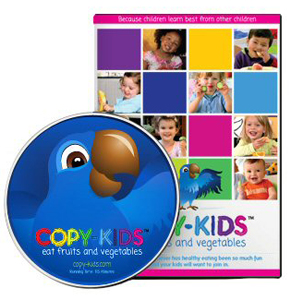Admittedly, I was somewhat skeptical about the video Copy-Kids eat fruits and vegetables, but I was still interested in reviewing it. I was sure that it could not hurt, but I wasn’t sure if it would be as powerful as all of the testimonials I had read.
My nephew is an awesome eater who loves healthy foods. It seems that he would eat as much quinoa as we would give him. However, he is somewhat moody on whether or not he wants fresh blueberries, so I sat down with him with a small bowl and turned on the blueberries segment. At my house, he never watches television, so that might account for his quiet focus. He sat in my lap, and I held the bowl of blueberries in front of us. As he watched the first couple of children, he held a blueberry in his fingers, then he looked back and fed one to me before eating one himself. He silently, but with increasing gusto, ate all of the blueberries and immediately wanted more.
Feeling scientific, I decided to try giving him a few slices of red pepper, which I don’t know that he has ever had. A few days prior, he had laughed with the girl giggling during the red pepper section of the Copy-Kids video, although playing the DVD on my computer without food around was a bit too distracting to hold his attention for the entire segment. He immediately started eating the slices of pepper and gave me bites while he was chewing each of his. He wasn’t able to sit through both segments, but that is not surprising for a one year old. Later, when I cut him another slice of pepper, he refused it, reaching for the pepper from which I had been slicing. Rather than just playing with the seeds, he started biting into it like an apple, just like he had seen one of the children do in the Copy-Kids video.
The DVD contains 12 chapters showing children eating and enjoying bell peppers, cucumbers, carrots, avocado, tomatoes, broccoli, oranges, bananas, raspberries, strawberries, apples, and blueberries. The extras section contains outtakes and an interview with Dr. Jay Gordan, MD, FAAP, author of of Good Food Today, Great Kids Tomorrow discussing childhood nutrition and the developmental science behind Copy-Kids. As he says, “That’s just the way kids are, they love to copy other kids.” He points out that children look to you for general guidance, including nutrition and eating behaviors, so it is important for parents to model eating healthy foods also. However, children also pay attention to other children, and parents may not always approve of the example set by their children’s peers. If the kids in the neighborhood are seen snacking on less than desirable processed foods, Copy-Kids eat fruits and vegetables is a way parents can counteract negative peer pressure with positive peer modeling.
 Copy-Kids is designed for children six months to five years old. Copy-Kids eat fruits and vegetables is the first in a planned series of videos displaying desirable behaviors in kids. Other planned videos include tooth brushing, exercising, tying shoes, and letter and number recognition. I liked that Copy-Kids eat fruits and vegetables showed kids being kids; the kids were allowed to play with their food, talk, and be silly. Copy-Kids may be providing some positive modeling for parents as well to counteract the tendency to hurry children through meals. Children of various ages and ethnicities took part in Copy-Kids eat fruits and vegetables making it more likely that your child would connect with one of the children. It also makes it even more appropriate for me to add to the list of resources I provide as part of the Nutrition: Nurture, Health & Behavior course I teach for MLJ Adoptions, Inc.
Copy-Kids is designed for children six months to five years old. Copy-Kids eat fruits and vegetables is the first in a planned series of videos displaying desirable behaviors in kids. Other planned videos include tooth brushing, exercising, tying shoes, and letter and number recognition. I liked that Copy-Kids eat fruits and vegetables showed kids being kids; the kids were allowed to play with their food, talk, and be silly. Copy-Kids may be providing some positive modeling for parents as well to counteract the tendency to hurry children through meals. Children of various ages and ethnicities took part in Copy-Kids eat fruits and vegetables making it more likely that your child would connect with one of the children. It also makes it even more appropriate for me to add to the list of resources I provide as part of the Nutrition: Nurture, Health & Behavior course I teach for MLJ Adoptions, Inc.
While screen time is limited at my house, Copy-Kids eat fruits and vegetables will be placed on the approved shelf. Hopefully, we will eventually add other Copy-Kids videos as well when they are released. If you would like to check out Copy-Kids eat fruits and vegetables, you can visit their website.
Also Read:
Candy-Free Potty Training Should be the Norm, Not the Exception
